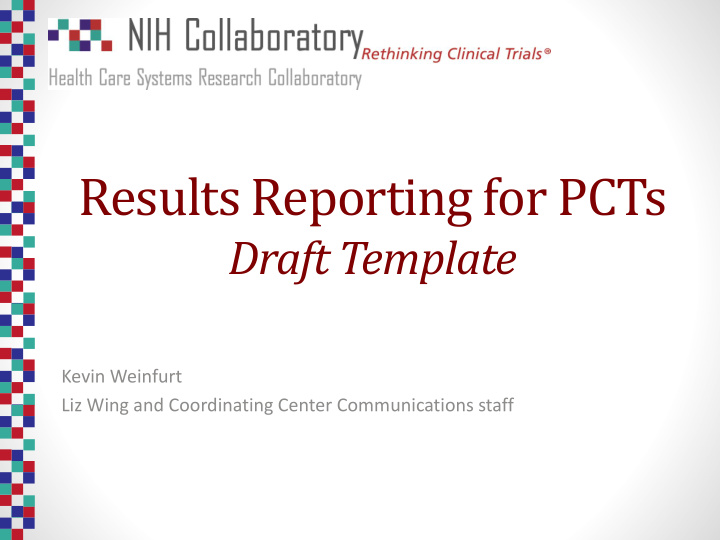



Results Reporting for PCTs Draft Template Kevin Weinfurt Liz Wing and Coordinating Center Communications staff
Background • CONSORT guidance exists, but • CONSORT was last updated in 2010 (Moher 2010 BMJ) • Pragmatic trial extension was developed in 2008 (Zwarenstein 2008 BMJ) • Numerous other CONSORT extensions are potentially useful for PCT reporting: PROs, CRTs, Harms, Abstracts • Lessons learned from the Demonstration Projects can inform the need for updated guidance on reporting
CONSORT and Extensions Description Link CONSORT website http://www.consort-statement.org/ Moher D, Hopewell S, Schulz KF, et al. CONSORT Moher 2010, PubMed abstract 2010 explanation and elaboration: updated guidelines for reporting parallel group randomised trials. BMJ. 2010;340:c869. PMID: 20332511 CONSORT checklist and explanations http://www.consort-statement.org/checklists/view/32-consort/66- title CONSORT extensions Designs Cluster trials Noninferiority and equivalence trials Pragmatic trials N-of-1 trials Interventions Herbal medicinal interventions Nonpharmacologic treatment interventions Acupuncture interventions Data Patient-reported outcomes Harms Abstracts
Selected Sections Added • We looked to the CONSORT guidance and extensions to devise a template that follows the checklist headings. • New areas are emerging related to the conduct of PCTs that the CONSORT checklist and guidance may not address adequately, which we added guidance for: • Wider stakeholder and health system involvement in conduct of PCTs • Human subjects protection • Secondary use of EHR data
Stakeholder engagement METHODS Stakeholder engagement (p 3) Because PCTs are generally conducted as part of routine care and are meant to immediately inform the delivery of care, engagement with relevant stakeholders — patients, delivery system leaders, IT personnel, clinicians, and other frontline providers — is important. Briefly describe the extent to which stakeholders were involved (e.g., defining the study question, designing the study, developing workflows, assessing feasibility).
Human subjects protection METHODS Human subjects protection (p 4) Describe approval by an ethics committee (e.g., an institutional review board). Include details of the type (written, oral, information sheet) and mode (electronic, mail, in-person) of informed consent used, or explain if the trial was determined exempt from requiring informed consent. If applicable, describe the existence of a data monitoring committee. For CRTs, indicate whether consent was obtained from cluster representatives or individual cluster members, or both. Describe whether consent was obtained before or after randomization.
EHR data use METHODS EHR data use (p 5) If the source of data was from a clinical or billing database instead of one created primarily for research, describe: • The steps used in gaining permission to use the data • How the population of interest was identified (i.e., development of phenotypes, use of ICD-10 codes) • The process for linking data from different sources • Assessment of the quality of the data • Data management during the study • The plan for archiving or sharing the data after the study
Questions • Are the reporting elements in this template appropriate? • Are the elements comprehensive? • Do we want to include a checklist similar to CONSORT’s?
Recommend
More recommend